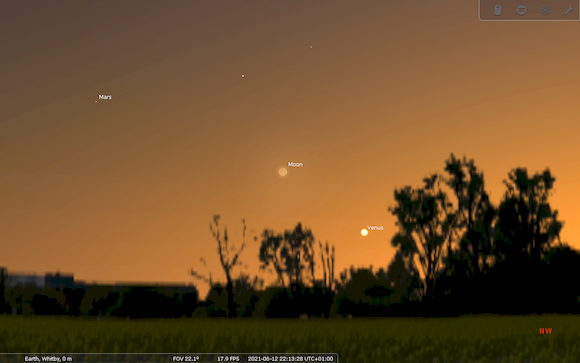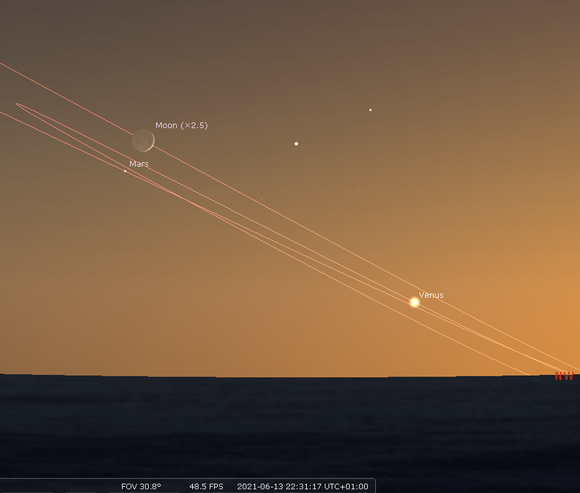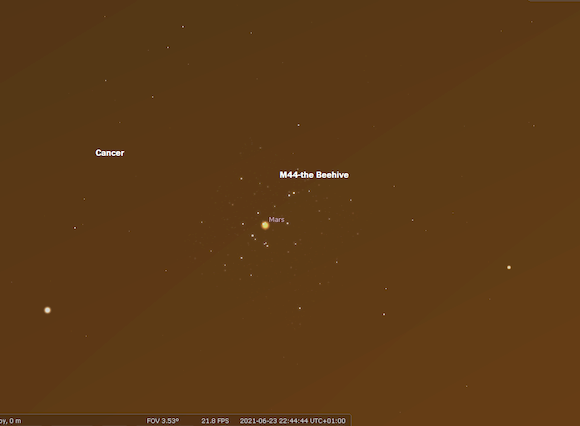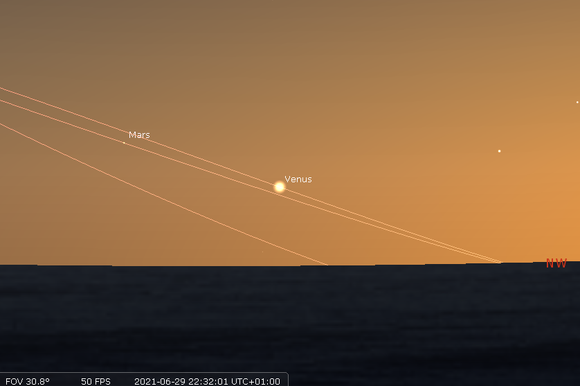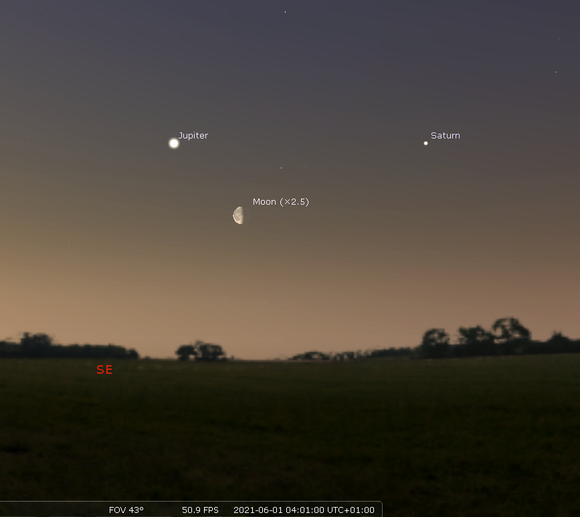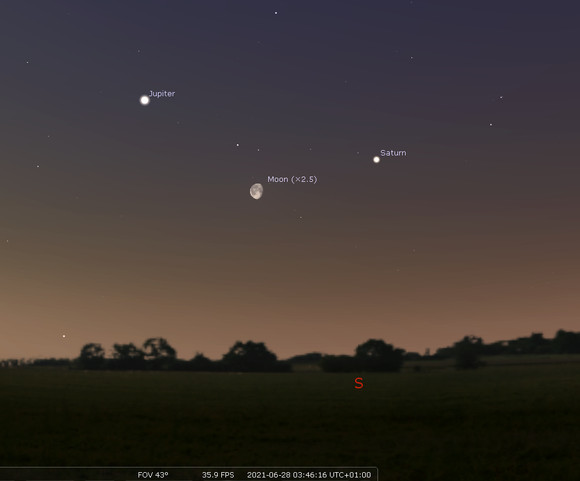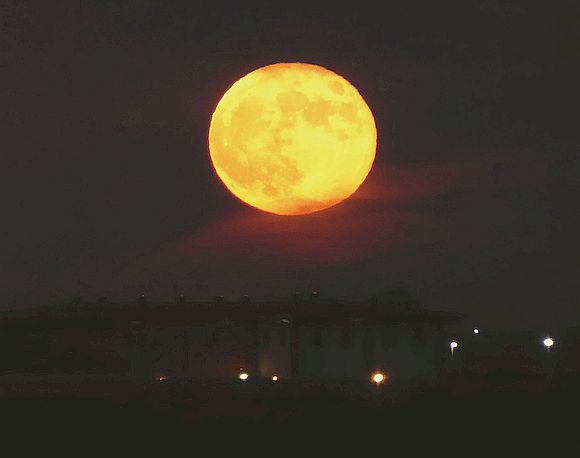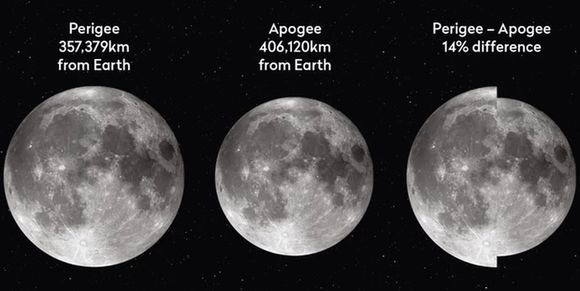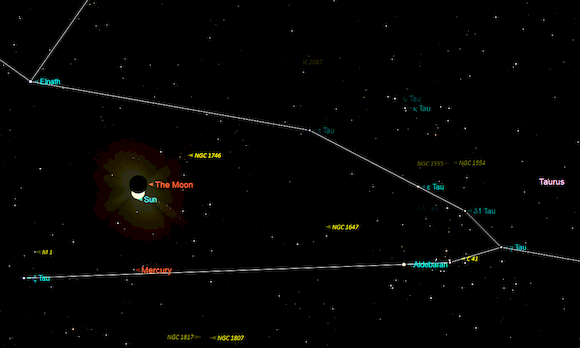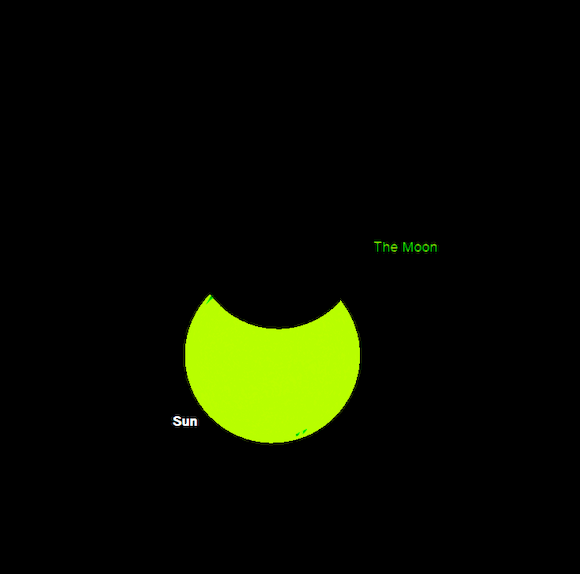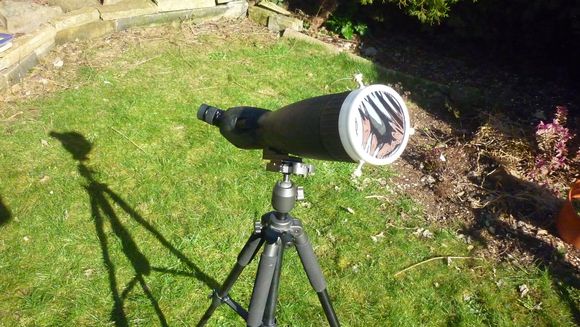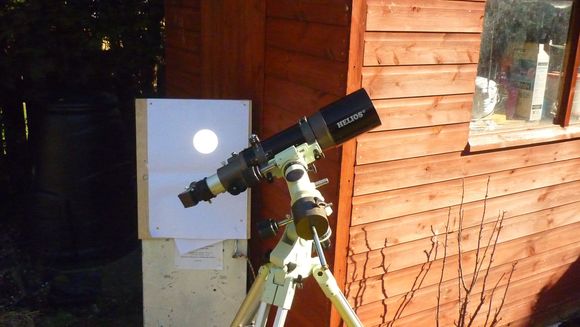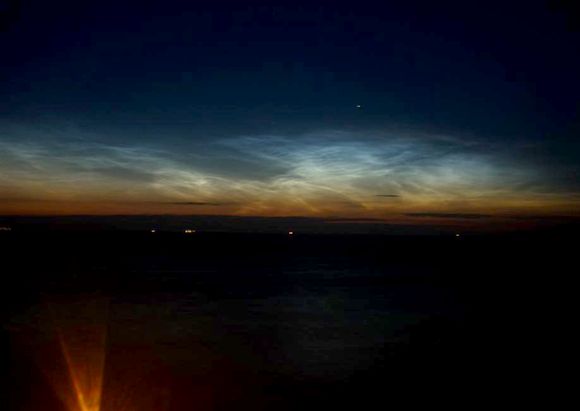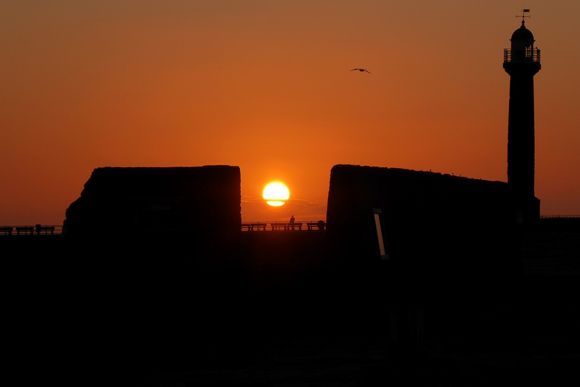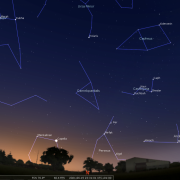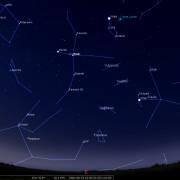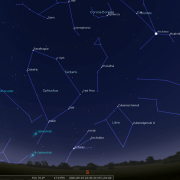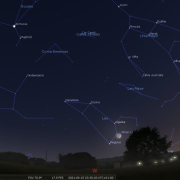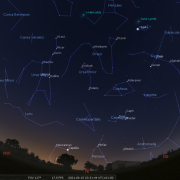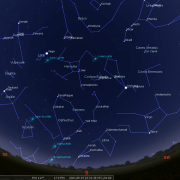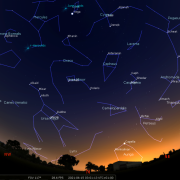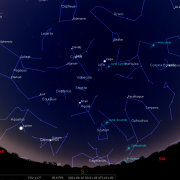In this month's Sky Notes:
- Planetary Skylights
- Strawberry Super Moon
- Partial Solar Eclipse
- June Meteors
- Noctilucent cloud season
- June 2021 Sky Charts
Planetary Skylights - Brief
Mercury is once again lost to solar glare, whilst Mars will have almost departed by the end of the month. Venus, despite its brilliance, struggles to make inroads into the evening sky. Jupiter and Saturn should be considered overnight objects and are best placed in the dawn sky, dawn being around 04:00hrs! The highlight of the month (cloud permitting) will be a partial solar eclipse, visible from the UK during the late morning of June 10th. June evenings are surprisingly bright from the UK, with light not faltering until almost 22:30hrs BST. Even then, nautical twilight levels are barley reached and astronomical twilight (true darkness) will be absent until early August. Dawn breaks around 03:15hrs, which is most people's idea as being the middle of the night! It's not surprising then that catching sight of a planet, let alone identifying stars and constellations is a tad more challenging. Yet planets are still to be found in the night sky, if you know when and where to look.
 After a long apparition, Mars is now sliding down in the NW, meeting Venus at the end of the month. Look for them in the final week just above the horizon around 22:30hrs. Mars will reside to the left of Venus. At the start of June, Mars resides lower left of Pollux, one of the ‘Twins’ in Gemini. Both will have an amber lustre with Mars (now at magnitude +1.75) the fainter of the two. By mid month Mars has moved into Cancer and from June 21st to 25th the red planet passes directly in front of open star cluster M44, the ‘Beehive'. You will require a flat, uncluttered horizon to view this, being less than 9 degrees above the horizon and binoculars or a telescope to pick out the Beehive in the twilight sky. View around 22:40hrs. The crescent moon lies close to Mars on the 13th. As we move into July Mars is overwhelmed by twilight bringing its current apparition to an end.
After a long apparition, Mars is now sliding down in the NW, meeting Venus at the end of the month. Look for them in the final week just above the horizon around 22:30hrs. Mars will reside to the left of Venus. At the start of June, Mars resides lower left of Pollux, one of the ‘Twins’ in Gemini. Both will have an amber lustre with Mars (now at magnitude +1.75) the fainter of the two. By mid month Mars has moved into Cancer and from June 21st to 25th the red planet passes directly in front of open star cluster M44, the ‘Beehive'. You will require a flat, uncluttered horizon to view this, being less than 9 degrees above the horizon and binoculars or a telescope to pick out the Beehive in the twilight sky. View around 22:40hrs. The crescent moon lies close to Mars on the 13th. As we move into July Mars is overwhelmed by twilight bringing its current apparition to an end.
June 13th at 22:31hrs; Mars with slender crescent moon and Venus below.
Lines show planetary orbital path (click image for larger image)
 Given its brilliance, Venus is not as easy to spot as you may think hugging the NW horizon all month in the brighter twilight. At magnitude -3.9 Venus should easily cut through the evening twilight, but the lowly altitude appears to extinguish its brilliance somewhat. At the start of June Venus should be apparent by 21:30hrs and attains its maximum altitude in the NW (just 9 degrees) by the 22nd. Look for a very young moon upper left of Venus on the 12th, view at 22:05hrs. For most evenings this month there will be under 45 minutes to observe Venus. Through a telescope Venus exhibits a gibbous phase, however the low altitude will render the image very unstable. It is joined by Mars at the end of the month (see Mars)
Given its brilliance, Venus is not as easy to spot as you may think hugging the NW horizon all month in the brighter twilight. At magnitude -3.9 Venus should easily cut through the evening twilight, but the lowly altitude appears to extinguish its brilliance somewhat. At the start of June Venus should be apparent by 21:30hrs and attains its maximum altitude in the NW (just 9 degrees) by the 22nd. Look for a very young moon upper left of Venus on the 12th, view at 22:05hrs. For most evenings this month there will be under 45 minutes to observe Venus. Through a telescope Venus exhibits a gibbous phase, however the low altitude will render the image very unstable. It is joined by Mars at the end of the month (see Mars)
Dawn Planets
 Jupiter and Saturn continue to make inroads into the dawn sky and start rising before midnight later in the month. To make the most of observing the two gas giants you will need to rise very early, around 02:30hrs! By then both lie in the SSE approximately 20 degrees above the horizon. Saturn leads Jupiter and at magnitude + 0.35 its pearly white presence is relatively conspicuous. The rings are now gradually closing up again, with the North Pole tilted toward Earth by nearly 17 degrees. In the eyepiece Saturn remains a glorious sight, you may also note Titan, its largest moon as a speck nearby.
Jupiter and Saturn continue to make inroads into the dawn sky and start rising before midnight later in the month. To make the most of observing the two gas giants you will need to rise very early, around 02:30hrs! By then both lie in the SSE approximately 20 degrees above the horizon. Saturn leads Jupiter and at magnitude + 0.35 its pearly white presence is relatively conspicuous. The rings are now gradually closing up again, with the North Pole tilted toward Earth by nearly 17 degrees. In the eyepiece Saturn remains a glorious sight, you may also note Titan, its largest moon as a speck nearby.
 Jupiter trails Saturn by around 45 minutes and is considerably more conspicuous shining at magnitude -2.6, so will be hard to miss unless hidden by scenery or housing. Through the eyepiece Jupiter is a fine sight, Galilean moons, belt features and even the great red spot, all make for fascinating observations when ‘seeing’ allows. The last quarter moon lies to the lower right of Jupiter on the 1st. On the 27th it lies to the lower right of Saturn then forms a triangle with Saturn and Jupiter the next morning. On the 29th the moon lies to the lower left of Jupiter. For most amateur astronomers Jupiter is perhaps more interesting to observe, chiefly because the Jovian atmosphere and moon system is far more dynamic. The belts and banding across the disk is in continuous flux and early observations suggest that segments of the equatorial belt zone have recently taken on an intense orange colour. The fascination surrounding the size and hue of the great red spot is also high on the observer’s agenda when Jupiter returns to sky after being hidden by the Sun's glare. Finally, there is the daily dance of the Galilean moons, throwing up a different configuration each time it is viewed. Jupiter then is always worth a peek.
Jupiter trails Saturn by around 45 minutes and is considerably more conspicuous shining at magnitude -2.6, so will be hard to miss unless hidden by scenery or housing. Through the eyepiece Jupiter is a fine sight, Galilean moons, belt features and even the great red spot, all make for fascinating observations when ‘seeing’ allows. The last quarter moon lies to the lower right of Jupiter on the 1st. On the 27th it lies to the lower right of Saturn then forms a triangle with Saturn and Jupiter the next morning. On the 29th the moon lies to the lower left of Jupiter. For most amateur astronomers Jupiter is perhaps more interesting to observe, chiefly because the Jovian atmosphere and moon system is far more dynamic. The belts and banding across the disk is in continuous flux and early observations suggest that segments of the equatorial belt zone have recently taken on an intense orange colour. The fascination surrounding the size and hue of the great red spot is also high on the observer’s agenda when Jupiter returns to sky after being hidden by the Sun's glare. Finally, there is the daily dance of the Galilean moons, throwing up a different configuration each time it is viewed. Jupiter then is always worth a peek.
Supermoon - What another one?
April brought the first of three consecutive super moon's in 2021, May's super moon (flower moon) was the nearest and largest of 2021, with this month's 'strawberry moon' - named after the wild strawberries that start to ripen during this month, is the smallest of the three. A full Moon is classed as ‘super’ when it occurs around 360,000km or less away from Earth, i.e when at or near perigee. It is thus distance that makes the moon 'super' making it appear larger in the sky. So, when the full moon rises 22:00hrs BST, it's time to grab your camera/imaging device of choice and go out picking wild strawberries!
Here she is! - the Flower super moon - rising over the Green Lane Centre - May 26th 2021...
Image by WDAS member Mark Dawson (click for larger image)
Partial Solar Eclipse
A partial solar eclipse will be visible from the UK (weather permitting) during the late morning of Thursday June 10th. From locations further north of the UK this eclipse will actually be rather spectacular, being an annular solar eclipse, with a ‘ring of fire’ around the silhouette of the New Moon. Had the moon been closer in its orbit the event would have been a total eclipse. From our shores, and more specifically from the Whitby area, the moon will bite roughly a third out of the Sun at maximum, which will be approximately 11:13hrs. The eclipse starts at 10:10hrs, finishing at 12:30hrs.
If you have no equipment the safest way to observe is by pinhole method, projecting the image with a pinhole in a piece of card onto a second white card, or by carefully using a small telescope to direct the Sun’s light onto the white card (as shown). Never look straight at the sun using any optical equipment or the naked eye without proper certified solar filters as permanent eye damage can occur. I find that to centre the Sun safely all you have to do is roughly line up the telescope in the direction of the Sun then use the shadow of the telescope as a guide. If it’s in line with the Sun then all you should have is a dark shadow disk of the telescope with a bright image in the centre.
To centre on sun without looking - roughly align and look for smallest cast shadow
(click for larger image)
Make sure that you have the finder scope covered with its caps on to prevent you accidentally viewing the bright Sun and only uncap the main telescope when you are ready to observe. Ensure that equipment aimed at the sun is not left unattended, Children and adults can be curious by nature. If you have a pair of Eclipse glasses stashed away in drawer somewhere, check them over, but remember, they are only for the eyes and must never be placed in front of a binocular, telescope or camera gear as they are not designed for that purpose. Binoculars can also be used to produce a reasonably sized image but you MUST block off the half of the binocular not in use as it produces a second image which may overlap with the image you are using, also because someone may try to look up at the Sun directly and of course that could seriously damage their eye.
Projecting image of Sun onto white card in shade, note finder scope removed.
(click for larger image)
Sadly, there will not be an organised society solar event for this eclipse, falling on a Thursday, a work day for many members. That's not to say those members who can view the eclipse, will be idle. I'm sure that, weather permitting; some members will be observing and hopefully acquiring images of the phenomena. We look forward to seeing them. The next partial solar eclipse visible from the UK will be 25th October 2022 with another one in March of 2025. A 90% eclipse will be visible on the evening of August 2nd 2027.

Meteor activity throughout June is at very low level for a number of reasons. The short, light nights is certainly one reason, but the trickle of low activity that is present chiefly comes from the ecliptic, which from the UK is low to south at this time of year. Plus, the minor showers that are apparent produce a handful of meteors at best. The Ophiuchids, the radiant of which lies near Theta Ophiuchi - approximately 15 degrees east of Antares, may produce 5 or so per hour with peaks on June 9th and 19th. The Beta Taurids are associated with debris left by Comet P/Encke, but unfortunately the shower occurs during daylight hours over the course of June. Radio detection methods do seem to indicate the shower is one of the strongest 'radio meteor showers' of the year. The Alpha Cygnids yield just a few meteors per hour near the end of June. The radiant lies close to Deneb, which is at least high in the sky!
By the end of May Noctilucent Cloud activity normally commences. Noctilucent cloud is filamentary in structure, having a characteristic silvery-blue colour. It forms almost exclusively between latitudes 50 and 60 degrees north, high in the upper atmosphere-around 50 miles, five times higher than normal clouds. As twilight persists well into the night throughout late May, June and early July, this type of cloud formation can appear above the northern horizon long after sunset, often around midnight, shining quite distinctly. It is thought Noctilucent clouds form when water vapour condenses at the low temperatures that prevail at such altitudes onto particles suspended in the air, possibly pollutants from industrial sources, even aircraft. Do then keep a watch low to the north towards the month's end.
The summer solstice in the northern hemisphere falls on June 21st this year, when the Sun reaches its greatest altitude in the sky on the ecliptic; the path it takes across the sky during a year. Solstice comes from the Latin words sol, meaning Sun and sistere, meaning to come to a stop or stand still. On the day of the June solstice, the Sun reaches its northernmost position, as seen from the Earth. At that moment, its zenith does not move north or south as during most other days of the year, but it stands still at the Tropic of Cancer. It then reverses its direction and starts moving south again. The opposite happens during the December solstice. Then, the Sun reaches its southernmost position in the sky corresponding to the Tropic of Capricorn, standing still before reverses its direction towards the north.
It is often wrongly assumed that Earth lies closer to the Sun at this time of year; in fact the opposite is true. Earth is actually furthest from the Sun on July 4th at almost 95 million miles, nearly 3 million miles more than when at its closest approach in early January. It is the inclination of the northern hemisphere towards the sun which causes days to feel warmer due to the higher concentration of sunlight per unit area. Think of this as being like a spot light directed onto to the palm of your hand, your palm feels hotter under direct radiation, whereas when the light is tilted, the angle reduces the heat intensity. The actual intensity of solar radiation in June is equivalent to approximately 1.2KW of heat for each square metre on the surface!
The position of the summer solstice currently stands on the Gemini-Taurus constellation border but it wasn’t always so. Thousands of years ago this position stood before the stars of Cancer in the northern hemisphere, but has subsequently shifted due of the effects of precession, Earth’s slow axial wobble. From our latitude we never see the Sun overhead, however anywhere between latitude 23.5 degrees North, and latitude 23.5 degrees South, the Sun can appear directly overhead, casting no shadows, a phenomena astronomers in antiquity duly noted. Because the summer solstice then stood before the stars of the constellation Cancer, the latitude of 23.5 degrees north eventually became known as the tropic of Cancer. Similarly, the Sun then stood before the stars of Capricorn when at its southern limit on the ecliptic (the winter solstice) 23.5 degrees south of the celestial equator and the origin of the tropic of Capricorn. Astronomers and scientists use the date of the June solstice to mark the beginning of summer in the Northern Hemisphere, for meteorologists, on the other hand, summer began almost three weeks earlier on June 1. Although known as the longest day, earliest sunrise and latest sunset times do not occur on the summer solstice date. From Whitby earliest sunrise falls around June 16th at 04:25hrs, whilst latest sunset occurs on June 25th at 21:42hrs. It is the duration of useable daylight which reaches a maximum on the 21st, which from Whitby is just over 17 hours, leaving a meagre 4 hours of semi darkness. Considered by most people as the date of the June solstice, the 21st is not the only date it can happen. In fact the summer solstice can fall anytime between June 20 and June 22. June 22 solstices are rare - the last one took place in 1975 and there won't be another one until 2203!
May 2021 Sky Charts
Additional Image Credits:
- Planets and Comets where not otherwise mentioned: NASA
- Sky Charts: Stellarium Software and Starry Night Pro Plus 8
- Log in to post comments

